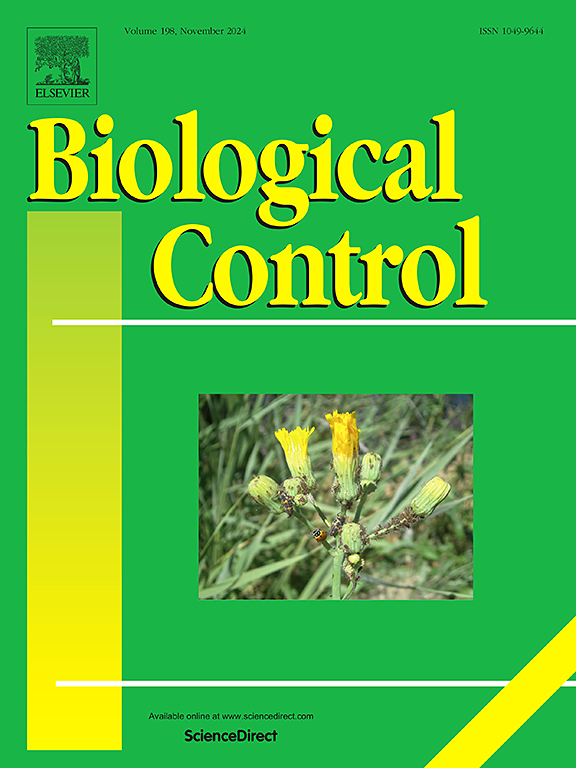Combining two parasitoids (Asecodes hispinarum and Tetrastichus brontispae) for biological control of coconut leaf beetle
IF 3.7
2区 农林科学
Q2 BIOTECHNOLOGY & APPLIED MICROBIOLOGY
引用次数: 0
Abstract
The coconut leaf beetle (CLB), Brontispa longissima, is a major threat to coconut production worldwide, causing widespread and important losses throughout the tropics. Two eulophid parasitoids, larval parasitoid Asecodes hispinarum and pupal parasitoid Tetrastichus brontispae, are the dominant natural enemies of CLB. However, the combined use of these species for biocontrol has not been systematically explored. We analyzed the interactions of A. hispinarum and T. brontispae and evaluated possible deployment strategies by determining the outcomes of releases under realistic agricultural conditions. Our laboratory studies showed that the concurrent release of the two parasitoid species did not reduce either species lifespan or reproductive output, and it significantly enhanced the impact on CLB. A 3:1 ratio of A. hispinarum to T. brontispae, a 10:1 parasitoid-to-pest ratio, and a regimen of five consecutive monthly releases proved to be the most effective strategy in the laboratory. When this combined release approach was used in field trials over a two-year period, there were significant reductions in pest densities and higher parasitism rates than single-species releases. This study highlights the potential of integrating multiple parasitoid species to improve biological control programs.
结合两种寄生蜂对椰子叶甲虫的生物防治
椰叶甲虫(Brontispa longissima)是全球椰子生产的主要威胁,在整个热带地区造成广泛和重大的损失。两种拟真寄生蜂是CLB的优势天敌,幼虫寄生蜂Asecodes hispinarum和蛹寄生蜂Tetrastichus brontispae。然而,还没有系统地探索这些物种的生物防治联合使用。本研究通过确定实际农业条件下的放生结果,分析了黄颡鱼和T. brontispae的相互作用,并评估了可能的放生策略。我们的实验室研究表明,两种寄生蜂同时释放并不会降低其寿命和繁殖量,但会显著增强其对CLB的影响。结果表明,以3:1的比例和10:1的寄生蜂/害虫比例,每月连续放生5次是最有效的放生策略。在为期两年的田间试验中采用这种联合释放方法,与单一物种释放相比,害虫密度显著降低,寄生率更高。本研究强调了整合多种拟寄生蜂来改善生物防治方案的潜力。
本文章由计算机程序翻译,如有差异,请以英文原文为准。
求助全文
约1分钟内获得全文
求助全文
来源期刊

Biological Control
生物-昆虫学
CiteScore
7.40
自引率
7.10%
发文量
220
审稿时长
63 days
期刊介绍:
Biological control is an environmentally sound and effective means of reducing or mitigating pests and pest effects through the use of natural enemies. The aim of Biological Control is to promote this science and technology through publication of original research articles and reviews of research and theory. The journal devotes a section to reports on biotechnologies dealing with the elucidation and use of genes or gene products for the enhancement of biological control agents.
The journal encompasses biological control of viral, microbial, nematode, insect, mite, weed, and vertebrate pests in agriculture, aquatic, forest, natural resource, stored product, and urban environments. Biological control of arthropod pests of human and domestic animals is also included. Ecological, molecular, and biotechnological approaches to the understanding of biological control are welcome.
 求助内容:
求助内容: 应助结果提醒方式:
应助结果提醒方式:


